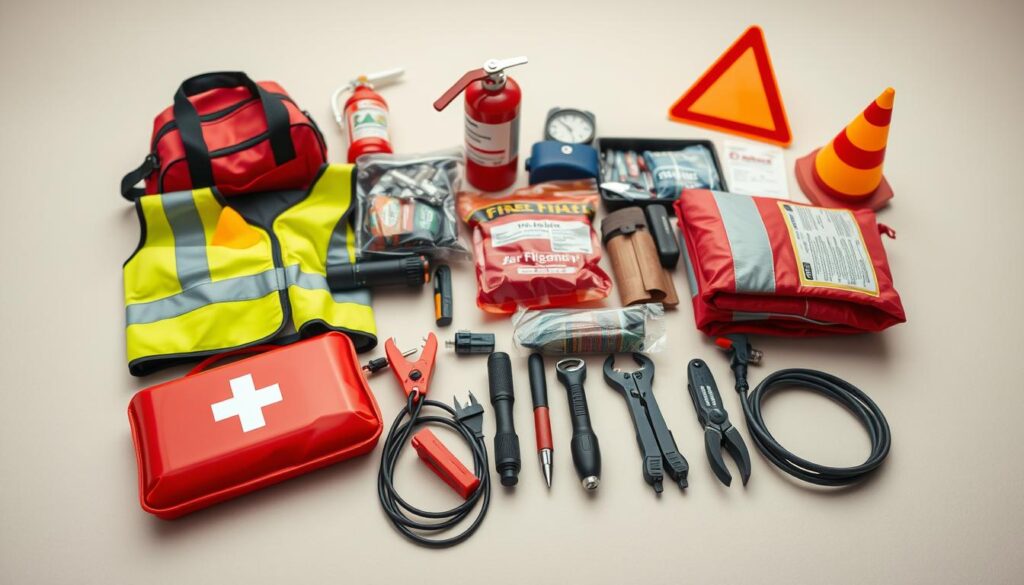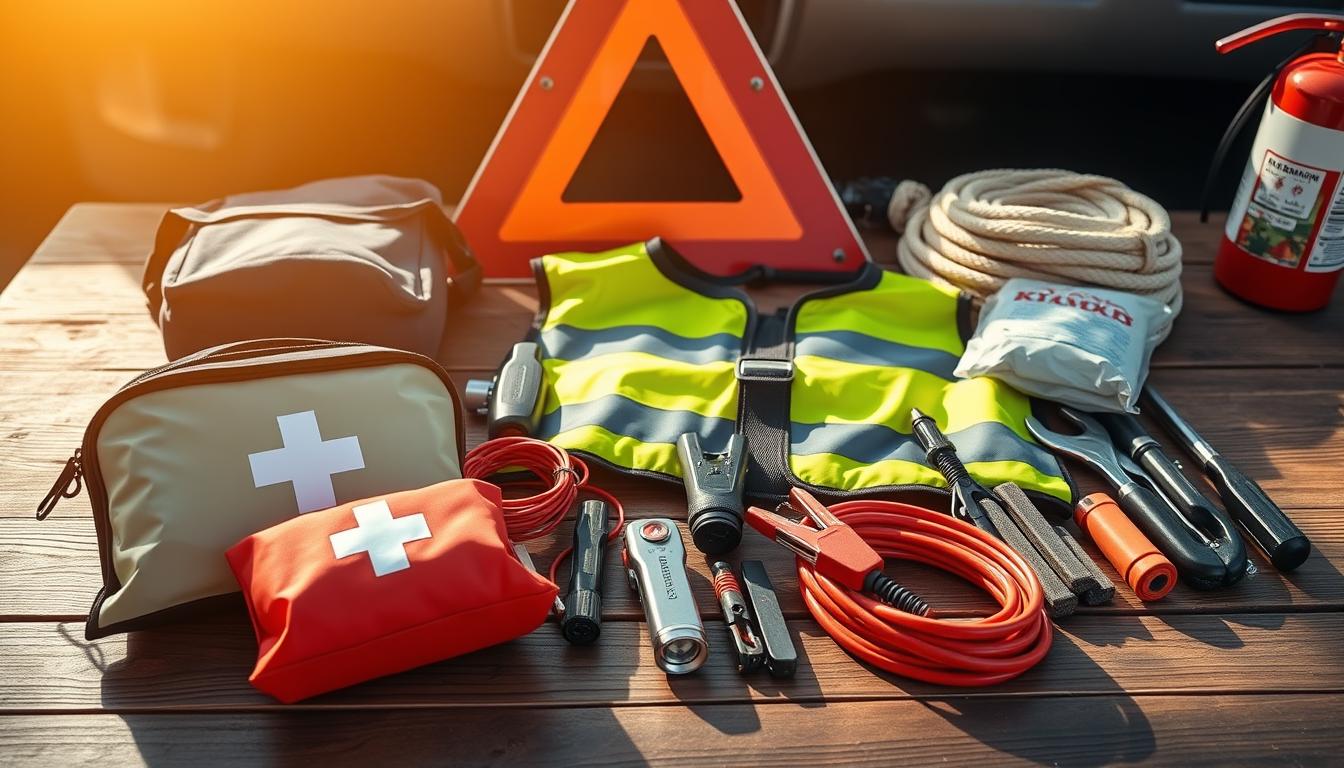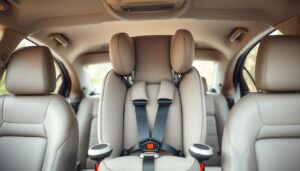Emergency Essentials for Your Car
Did you know that a driver will experience a vehicle breakdown roughly once every five years? That statistic represents millions of unforeseen stops on the road annually. From a simple flat tire to being caught in a sudden snowstorm, trouble can find anyone.
Being prepared transforms a potential crisis into a manageable situation. This guide is your friendly roadmap to creating a reliable safety kit for your vehicle. We want you to feel confident every time you turn the key.
You will learn how to select durable supplies that you can trust. We cover what to pack for different seasons and driving conditions. Building your personalized solution is simpler and more affordable than you might think.
Let’s get you ready for a safer journey, no matter where the road takes you.
Key Takeaways
- Vehicle breakdowns are a common occurrence for drivers.
- Proper preparation can turn a roadside crisis into a manageable event.
- A well-stocked kit provides peace of mind and enhances personal safety.
- This guide will help you choose high-quality, reliable supplies.
- You can customize your kit based on your specific needs and budget.
- Seasonal changes and driving habits should influence your kit’s contents.
- Creating a comprehensive safety pack does not have to be difficult or expensive.
Understanding Roadside Emergencies

Roadside troubles can strike without warning, turning a routine drive into a challenging situation. Recognizing the most common scenarios helps motorists prepare effectively for what they might encounter.
Common Causes and Unexpected Events
Mechanical failures rank among the top reasons drivers find themselves stranded. Dead batteries, flat tires, and engine problems can happen anywhere.
Other unexpected events include running out of fuel in remote areas or getting stuck in mud. Visibility issues during heavy rain or fog also create unsafe driving conditions.
The Role of Severe Weather and Accidents
Severe weather creates particularly dangerous situations for travelers. Winter snowstorms can trap people in their vehicles for extended periods.
Extreme summer heat poses health risks and can cause engine overheating. Accidents require immediate access to safety equipment and first aid supplies.
| Emergency Type | Common Causes | Key Risks |
|---|---|---|
| Mechanical Failure | Dead battery, flat tire, engine issues | Stranded in unsafe locations |
| Weather Related | Snowstorms, extreme heat, flooding | Extended waiting, health concerns |
| Accidents | Collisions, fender-benders | Injury, secondary accidents |
These situations don’t discriminate between experienced and new drivers. Proper preparation ensures better outcomes when facing unexpected road challenges.
Why a Reliable Car Emergency Kit Is Essential

Beyond the physical items, a thoughtfully assembled automotive kit provides a powerful psychological advantage for any traveler. Knowing you have a plan and the right gear drastically reduces the stress of long journeys.
This preparedness allows you to face minor setbacks with confidence instead of panic. It ensures your entire family can stay safe and comfortable if a delay occurs.
Peace of Mind on the Road
The greatest benefit is often the sense of security. This peace of mind is invaluable, turning potential fear into calm control.
You travel knowing you are not helpless. This confidence is especially important when driving with children or older passengers.
Saving Time and Money in Crises
Practical benefits are equally significant. Addressing a flat tire or dead battery yourself can save hours of waiting.
It also avoids costly service calls. Your initial investment in a good emergency kit pays for itself quickly.
| Benefit | Description | Direct Impact |
|---|---|---|
| Psychological Security | Reduces anxiety and stress while driving. | Confident and calm decision-making. |
| Enhanced Personal Safety | Provides tools to handle situations and stay safe. | Less reliance on external help, faster resolution. |
| Financial Savings | Prevents expensive towing and service fees. | The kit pays for itself after a single use. |
Emergency Essentials for Your Car: Must-Have Supplies

The foundation of roadside confidence lies in assembling a few critical categories of supplies. These core items form the backbone of any reliable emergency kit.
Think of your kit as having four key jobs: medical care, visibility, communication, and basic vehicle fixes. Focusing on these areas ensures you’re prepared for the most common situations.
First Aid, Safety, and Communication Tools
A comprehensive first aid kit is non-negotiable. Cuts or scrapes can happen during an accident or a simple tire change. Immediate first aid can prevent a small issue from becoming a big problem.
Visibility items like reflective triangles keep you safe from passing traffic. This is crucial at night or in bad weather. A sturdy flashlight helps you see, signal for help, and make repairs safely in the dark.
Communication tools are your lifeline. A power bank for your phone is vital. Consider a battery-powered radio for weather alerts and emergency updates if cell service fails.
Critical Items Like Jumper Cables and Flashlights
Jumper cables are arguably one of the most used supplies. A dead battery is a frequent reason for being stranded. Good quality jumper cables mean a quick restart with a helper’s vehicle.
Your flashlight should be bright and reliable. It’s not just for seeing—it’s for being seen. A working light is indispensable for any nighttime emergency.
These fundamental kit components address the majority of roadside challenges. They provide a strong base for your vehicle’s safety and your peace of mind.
Top Items Every Emergency Kit Should Include

Building your roadside assistance package starts with identifying the most practical items for real-world scenarios. These core components address both medical needs and mechanical problems you might encounter.
First Aid Kits, Radios, and Reflective Warning Devices
A comprehensive first aid kit should contain adhesive bandages, elastic bandages, and antibiotic ointment. Include antiseptic wipes, sterile gauze pads, and instant cold packs for proper wound care.
Reflective warning devices provide crucial visibility to alert other drivers. These items prevent secondary accidents during nighttime emergencies.
Jumper Cables, Tire Repair Kits, and Tools
Quality jumper cables should be 10-12 feet long with heavy-duty construction. Good cables safely jump-start modern vehicle batteries.
Tire repair kits offer temporary fixes for minor punctures. A multi-tool combines numerous functions in one compact package for various situations.
| Item Category | Key Features | Primary Benefit |
|---|---|---|
| First Aid Supplies | Bandages, ointments, sterile pads | Immediate medical assistance |
| Visibility Tools | Reflective devices, LED lights | Prevent secondary accidents |
| Repair Equipment | Jumper cables, tire kits | Quick roadside solutions |
These fundamental kit components create a strong foundation for handling common roadside challenges effectively.
How to Choose the Best Emergency Preparedness Kit
A well-chosen pre-made safety collection can save you time while ensuring you have reliable equipment when needed. Focus on durable construction that withstands vehicle vibrations and temperature extremes.
Checklist for Quality and Durability
Examine each component’s quality before purchasing any preparedness package. Look for reputable manufacturers rather than cheap substitutes.
Consider how many people travel in your vehicle and your typical trip length. Climate conditions you regularly encounter should guide your selection too.
Comparing Kit Options and Trusted Brands
The American Red Cross offers excellent options approved by their Scientific Advisory Council. Their kits meet rigorous safety and quality standards.
Specific American Red Cross choices include the Car Survival Kit with Winter Supplies (28 pieces). The Be Red Cross Ready First Aid Kit (73 pieces) provides comprehensive medical supplies.
| Kit Name | Piece Count | Primary Focus | Best For |
|---|---|---|---|
| Car Survival Kit | 28 pieces | Winter conditions | Cold climate drivers |
| Be Red Cross Ready | 73 pieces | First aid | Family vehicles |
| Emergency Preparedness Auto Kit | 45 pieces | General roadside needs | Daily commuters |
| Deluxe 3-Day Kit | 52 pieces | Extended preparedness | Long trips, remote areas |
Read customer reviews to understand real-world performance. The right emergency kit depends on your individual driving patterns and regional needs.
Building Your Custom Car Emergency Kit
Creating your own personalized roadside safety collection puts you in complete control of what goes into your vehicle’s preparedness system. This hands-on approach ensures every component meets your specific needs and driving habits.
Start by selecting a sturdy storage container that fits well in your trunk. A heavy-duty nylon bag or plastic bin keeps all your supplies organized and protected from the elements.
Step-by-Step Guide for Assembly
Begin with the foundation items that form the core of any reliable kit. Quality 12-foot jumper cables handle battery issues effectively. Include a bright flashlight with spare batteries for visibility during nighttime situations.
Your comprehensive first aid kit should contain bandages, antiseptics, and basic medical supplies. Don’t forget basic tools like screwdrivers and pliers for minor repairs.
Add vehicle-specific components that match your car‘s needs. Extra fuses that fit your electrical system are crucial. Include a tire pressure gauge and ensure your spare tire is properly inflated.
Safety and visibility items protect you during roadside stops. A large HELP sign alerts other drivers. Reflective triangles and a plastic tarp create a safer work area.
Survival essentials become important during extended waits. Pack bottled water and energy bars, remembering to replace them yearly. Warm blankets and duct tape provide comfort and temporary fixes.
Organize your kit contents in clear bags by category. Label everything clearly for quick access. Customize based on your family’s specific requirements.
Practice using your emergency equipment before you need it. Familiarity with your car jack and basic procedures builds confidence for real situations.
Seasonal Adjustments & Extra Tips for Roadside Safety
Seasonal driving conditions demand specific adjustments to your roadside preparedness supplies. Different weather patterns present unique challenges that require specialized equipment.
Additional Supplies for Winter Conditions
Cold weather requires extra survival gear. A compact shovel helps dig out of snow. Ice melt provides traction on slippery surfaces.
Warm gloves protect hands during outdoor work. Hand warmers maintain body heat in freezing conditions. An emergency blanket offers crucial warmth if stranded overnight.
Winter-specific items include an ice scraper and snow brush. Winter-formula windshield fluid prevents freezing. These additions transform your basic kit for cold weather survival.
Summer Essentials and Versatile Additions
Hot weather brings different risks. Extra water prevents dehydration during long waits. Sunscreen protects from harmful UV rays.
A sunshade keeps your vehicle interior cooler. Electrolyte drinks replace minerals lost through sweating. These summer supplies address heat-related dangers effectively.
Some items work year-round. Duct tape handles quick repairs in any season. Extra battery packs power various devices.
Work gloves protect hands during repairs. Rain ponchos shield from both rain and wind. Regularly update your kit‘s content based on seasonal needs.
Maintaining and Updating Your Emergency Kit
Your roadside safety collection requires regular attention to remain truly effective when you need it most. A well-maintained kit provides peace of mind, while neglected supplies can fail during critical moments.
Regular Inspections and Replacement Guidelines
Set a quarterly schedule to check your entire emergency kit. Test every flashlight and replace battery packs before they expire. Examine your first aid kit for outdated medications and sterile items.
Food and water need annual rotation. Swap out bottled water and energy bars to ensure freshness. Don’t forget your spare tire—check its pressure every six months.
Seasonal changes offer perfect opportunities for thorough reviews. Swap cold-weather gear for summer essentials as needed. Use these transitions to inspect all tools and equipment.
Keep your storage case organized with labeled bags. Date items when adding them to track replacement schedules. Set calendar reminders to make maintenance a regular habit.
Remember: a reliable vehicle safety system depends on consistent upkeep. Your preparedness kits should evolve with your family’s needs and driving patterns.
Conclusion
Every journey deserves the confidence that comes from proper roadside preparation. A comprehensive car emergency kit transforms from optional gear to absolute necessity when trouble finds you.
The benefits are clear: enhanced safety through visibility equipment, peace of mind, and practical savings. Building your solution is straightforward and affordable.
Customize your kit based on passengers, climate, and travel patterns. Include essential categories like first aid supplies, jumper cables, and seasonal items.
Remember that maintenance keeps your tools reliable. Regular checks ensure everything works when needed most.
This small investment pays off in protection and confidence. Browse trusted collections from AAA or start gathering items today. Join prepared drivers who handle any road conditions with assurance.
FAQ
What are the absolute must-have items for a basic car emergency kit?
How often should I check and update my vehicle’s emergency supplies?
Are pre-assembled kits from brands like the American Red Cross a good value?
What extra items should I add for winter driving safety?
Why are jumper cables so important for roadside preparedness?
Besides a first aid kit, what other safety tools are critical?

Adam Peter is a finance, travel, and automotive writer with over a decade of experience. He creates clear, practical content to help readers manage their money, explore the world with confidence, and make informed decisions about cars and travel gear. His work blends expert insight with real-world usefulness.




